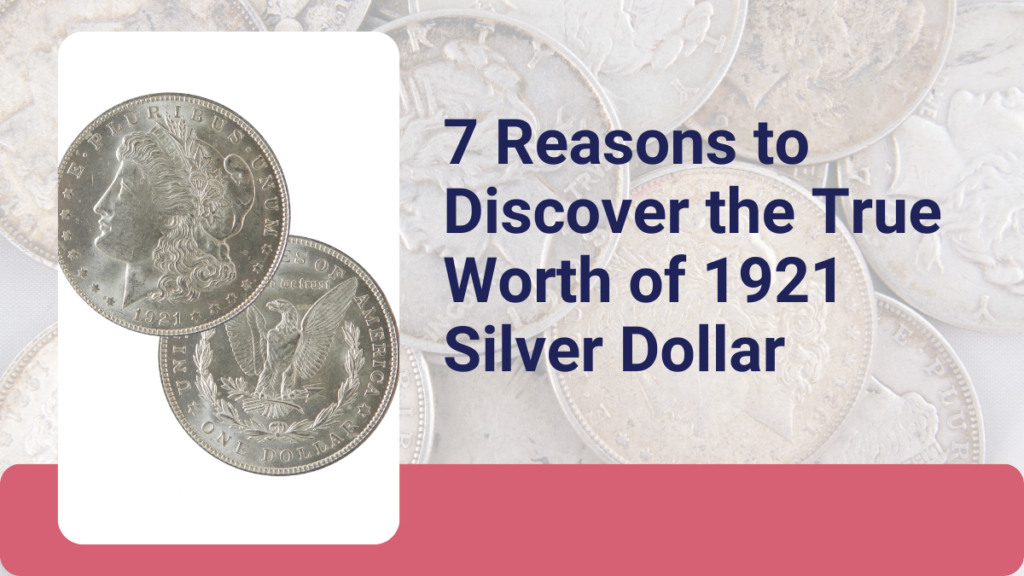An extraordinary American coin, the 1921 Morgan silver dollar has captivated the interest of numismatists and history buffs. Offering collectors a compelling investment opportunity, this symbolic piece of American currency recounts a bygone era of complex coinage legislation and U.S. politics (and economics) while possessing potential value far exceeding its face value. This article provides information on acquiring a 1921 Morgan silver dollar or ascertaining its approximate value.
What Is The 1921 Silver Dollar?
A considerable number of coin dealers and collectors favor silver dollars from 1921. This was a coin produced for a single year. These coins were struck by the United States Mint using brand-new dies after the reinstatement of Morgan dollar production after a thirteen-year hiatus.
Additionally, the 1921 silver dollar marked the conclusion of the Morgan dollar series; the Peace Silver dollar succeeded it. Overall, the value of the dollar in 1921 exceeds its perceived value. If the coin is in excellent condition and bears a significant error, it can be worth considerable money.
History Of The Silver Dollar In 1921
The first silver dollar was authorized to be minted in the United States of America under the Coinage Act of 1873. As the nation’s first silver currency, the Morgan Dollar was perpetually struck between 1878 and 1904, when production terminated.
Coincidentally, the nation experienced a Great Panic from 1893 to 1895, which led to wealth accumulation. At that time, a significant number of households were impacted by the pervasive economic inflation that was attributed to silver currency.
The Mint produced substantial silver coins for circulation from 1878 to 1903 until the silver reserves were ultimately depleted. The cessation of silver production for Morgan dollars occurred in 1904.
The United States would subsequently melt a substantial quantity of its silver coinage to save the British economy. During the height of World War I in the mid-1900s, the Germans conducted an aggressive slander campaign against the British. As a result of Germany’s assertion that British banknotes were worthless, Britain’s silver reserves were depleted due to a surge in demand.
To halt the onslaught, the Pittman Act of 1918 was ratified by the United States government. The Act authorized the melting of 270,232,722 silver dollars, at which point Great Britain purchased the silver at one dollar per troy ounce.
The United States had only a limited quantity of silver dollars remaining. After realizing this, they demanded that the silver dollar production resume in 1921.
At this juncture, the Mint had disposed of the dies used to strike the old Morgan dollars. Consequently, new dies were required to produce the redesigned Morgan coins.
In the same year, the Mint issued a new Peace dollar in commemoration of the conclusion of the First World War. Additionally, the Peace dollar was anticipated to supplant the Morgan silver dollar.
1921 Silver Dollar Grading
The 1921 silver dollar was challenging to strike due to its substantial size and weight. When grading silver dollars, pay particular attention to strike quality, particularly when evaluating uncirculated coins.
Circulating coins will generally be severely marred, with numerous design elements absent. Many years have passed since these coins were first struck, and they were mass-produced using centers of inferior quality.
Observe how Lady Liberty’s ear is obscured by her side hair while grading uncirculated coins. This portion of the coin was not struck precisely, so it may appear as though the uncirculated coin is worn; however, this is an intentional aspect of the design.
Before making a definitive determination regarding a coin’s unsaturated or Mint condition, it is advisable to consider additional characteristics.
A coin may not be a mint state dollar if a significant portion of the deterioration on its prominent features, such as the cap, Liberty’s forehead and cheekbone, the eagle’s eye, and the torso, is visible.
What Is The Value Of A 1921 Silver Dollar?
The silver dollar from 1921 is the most prevalent Morgan dollar. The Philadelphia, San Francisco, and Denver facilities produced approximately 87 million 1921 Morgan silver dollars.

There are three primary varieties:
- 1921 No Mint Mark Silver Dollar
- 1921 S Silver Dollar
- 1921 D Silver Dollar
Consider the worth of every variant.
1. 1921 No Mint Mark Silver Dollar Value
Approximately 44,690,000 Morgan silver dollars were minted at the Mint in Philadelphia in 1921 as part of the government’s initiative to revive the dollar after an extended absence.
The silver content undeniably enhances the coin’s intrinsic value, thereby rendering the 1921 silver dollar valuable more than its nominal value of $1. Aside from that, these coins were struck in large quantities, and the striking centers needed to be revised, resulting in coins of inferior quality overall compared to Morgan dollars minted before 1921.
A 1921 silver Morgan dollar grading G35 is valued at approximately $30 in circulated condition, whereas one graded AU50 can fetch around $36. Mint state dollars with the highest grade possible (MS67) can garner up to $11,500. An MS65 coin is valued at $215.
The most expensive silver dollar without a mint mark from 1921, as determined by the Professional Coin Grading Service (PCGS), was graded MS67 and sold for $19,975 in 2015.
2. 1921 S Silver Dollar Value
The San Francisco mint produced 21,695,000 silver dollars in 1921, the second-highest mintage that year.
The 1921 S silver dollar will remain valuable in grades below its nominal value. Expect to pay between $29.50 and $75 for most coins in circulated condition.
One silver dollar in flawless condition is valued at a maximum of $3,500 for a grade of MS66, whereas one silver dollar graded $67 fetches approximately $25,000.
Unsurprisingly, most numismatics are exclusively focused on higher-grade 1921 silver dollars. The scarcity of these coins results in their increased market value.
3. 1921 D Silver Dollar Value
In 1921, the Denver mint produced an estimated 20,345,000 silver Morgan coins. The issuance of Morgan coins by the Denver facility was an inaugural occurrence.
The 1921 D silver dollar is valued between $29.50 and $50 in circulation. Even in lower grades, this coin is valuable for more than its nominal value, partly because of its silver content.
Even in higher grades, the 1921 D silver dollar fails to generate a substantial fortune. This is due to the inferior strike of the coin in comparison to preceding Morgan dollars.
A coin designated MS62 is valued at approximately $100 in its mint state, whereas one graded MS67 can command a maximum of $50,000.
Is The 1921 Morgan Silver Dollar Rare?
In brief, the answer is no. In 1921, over 86 million Morgan dollars were issued from the three branch mints. Indeed, this year marks the most substantial silver dollar mintage in the history of the United States in a single year.
Additionally, the final year in which Morgan dollars were produced was 1921. Many of these coins have been conserved in an almost perfect state of pristine condition, rendering them reasonably priced to acquire.
How To Buy And Sell 1921 Morgan Silver Dollars?
Before selling your 1921 Morgan silver dollar, you should locate the most suitable marketplace. When possessing an exceptionally uncommon or valuable coin, it may be advisable to utilize reputable auction platforms such as Heritage Auctions. You may also attempt to sell your coin on online marketplaces such as eBay.
Morgan silver dollars are more straightforward to acquire. You can readily locate them on Amazon or eBay (be sure to compare prices before purchasing). Obtain pre-1921 Morgan silver dollars by approaching reputable dealers in precious metals, such as Lear Capital.
collectors are captivated by the 1921 silver dollar, regardless of whether Morgan or Peace designed it. It is a significant element of American history. A combination of historical significance, condition, scarcity, and market demand determine its value; for individuals seeking to ascertain the precise worth of their 1921 silver dollar, the most reliable consultation methods are to seek advice from a reputable coin dealer or to have the coin professionally graded.
Despite the dynamic nature of the collectible coin market, the 1921 silver dollar continues to be esteemed as a representation of America’s history, possessing an intrinsic worth that surpasses its nominal value.



